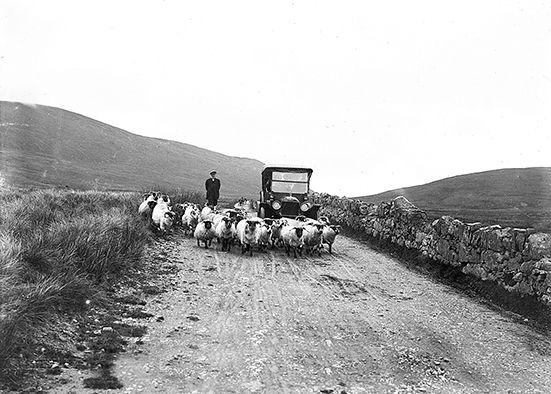Black-faced sheep killed off booley huts in the Mournes
Black-faced sheep killed off booley huts in the Mournes
4 May 2022

MAY has arrived. Summer is on its way. That means holidays, weekend breaks and maybe even a move to a summer home.
While the latter is a luxury reserved for the wealthy, this was not always the case. A summer migration to a more scenic area used to be an important farming tradition across Ireland.
It was known as ‘booleying’, which comes from the word ‘buaile’ (pronounced bool-yeh) and translates as a ‘feeding place’ or ‘milking place’.
Usually starting on May 1, farmers shifted their livestock from the lowlands to spend the summer months grazing upland areas — only returning home at the end of the harvest season in October.
Similar seasonal nomadism, or ‘transhumance’, was common across Europe, particularly in Alpine areas and the Mediterranean. It still occurs in rural Scandinavia, where farmers relocate to mountain cabins in June to help preserve their lowland meadows.
In Co Down, booleying was a lifeline for farmers without enough land to be self-sufficient. It alleviated pressure on the crops and freed up areas to grow hay. The fresh upland grass also helped maintain animal health and enabled larger herds to be kept.
Booleying was not just a man’s job. Whole families moved to the mountains to help milk cows and churn butter (an important economic resource).
Cutting turf was also important. Many butter containers have since been found buried in bogs — put there to preserve the butter but possibly also as a ritual offering (many ancient artefacts have also been found in bogs).
Then there was heather ale — a potent mix of heather, hops and honey that was a mainstay in local folklore, if not practice. Local legend suggests that it died out when the Vikings arrived.
A father and son were, supposedly, the last two Irishmen to know the secret. The Vikings promised to spare their lives if they shared the technique. The father, fearing his son would talk, convinced the Vikings that he would tell all if they killed his son first — so the boy would not suffer the shame of revealing the secret. The Vikings agreed and sacrificed the son. But the father refused to divulge and the secret of how to brew heather ale died with him.
This is why some of the summer houses, known as booley huts, were known as ‘Dane’s Stills’. They were usually a single, rectangular room that was much smaller than a winter house. In other parts of Ireland there is evidence that they had wattle walls, but in Co Down — in the Mourne Mountains — they were made of granite with ‘scraws’ (sods) of peat and heather for the roof.
Remains of booley huts can still be found beside the streams that run from Pot of Legawherry (west of Slieve Commedagh) down to Tollymore Forest. There are also remnants to the south-east of Millstone Mountain (lower slopes of Slieve Donard). At Hare’s Gap some stones are still laid out like the foundations of a small hut, although there are disputes about whether this was a booley hut or a sheep shelter.
By far the most popular area for booleying was beside Rocky Mountain in the western Mournes (one of three Mourne peaks with the same name). This area used to be a flat basin at 350m elevation called the Deer’s Meadow. It was a perfect location as it had a water source and flat land with a good view of the slopes where the cattle roamed. The Ordnance Survey Memoir of South Down noted in 1834 that:
“Deer’s Meadow [called by some King’s Meadow because people have their grazing in it free], is resorted to by great numbers of poor people in the summer months to graze their cattle; They bring with them their wives, children and little wretched furniture,
erect huts and live there for two months and sometimes more, and often cut their turf to serve for the next returning season, which done, they retire with their cattle to their former habitations.”
The Deer’s Meadow is also famous in Mourne folklore. It was the setting of a clash between two clan chiefs. Fergus of Glen Secis and Artan of Lecale were hunting an adult stag and eventually killed it in the Deer’s Meadow.
In the melee, both men’s favourite hounds also died. Fergus accused Artan of deliberately killing his dog, so he attacked him and left him for dead. But feeling guilty, he hung a votive bell in a nearby tree and went on a pilgrimage around Europe. Years later, he returned to find an elderly Artan still alive. The men reconciled, but local tradition is that the bell can still be heard ringing on dark, dreary nights.
Neither Fergus nor Artan would recognise today’s Deer’s Meadow. It was submerged when Spelga Dam reservoir was completed in 1957. Up to 20 booley huts drowned with it – although their memory lives on in the names of adjacent mountains, including Butter Mountain and Slievenamiskan (Sliabh Meascan) — ‘the hill of the butter store’.
Pre-flood archaeological excavations suggested the sites had been used by since prehistoric times. This matches other evidence, including mention of booleying in the Brehon Laws — the legal system that existed before King John imposed English Common Law in 1210.
While booleying outlasted him and continued until the 1800s, population growth, advancements in agrarian techniques, a trend towards enclosed land and the growing popularity of the potato eventually rendered it redundant across Ireland.
Yet in the Mourne Mountains, the shift towards sheep was the game-changer. Cattle, which had long been the custodians of the Mournes, were increasingly replaced by sheep in the 18th century (six sheep can live off the resources needed to sustain one cow). Booley huts then gave way to sheepfolds or ‘bochts’.
Sheep — particularly our own Mourne Blackface breed — are now synonymous with the Mournes. The start of May is the perfect time to remember that it was those same sheep which ended an ancient tradition that stretched back to prehistoric times.
They put booley huts out of business.


